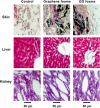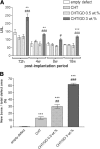Graphene Family Materials in Bone Tissue Regeneration: Perspectives and Challenges
- PMID: 30229504
- PMCID: PMC6143492
- DOI: 10.1186/s11671-018-2694-z
Graphene Family Materials in Bone Tissue Regeneration: Perspectives and Challenges
Abstract
We have witnessed abundant breakthroughs in research on the bio-applications of graphene family materials in current years. Owing to their nanoscale size, large specific surface area, photoluminescence properties, and antibacterial activity, graphene family materials possess huge potential for bone tissue engineering, drug/gene delivery, and biological sensing/imaging applications. In this review, we retrospect recent progress and achievements in graphene research, as well as critically analyze and discuss the bio-safety and feasibility of various biomedical applications of graphene family materials for bone tissue regeneration.
Keywords: Bone tissue regeneration; Coating; Drug delivery system; Graphene family materials; Guided bone regeneration membrane; Scaffold.
Conflict of interest statement
Competing Interests
The authors declare that they have no competing interests.
Publisher’s Note
Springer Nature remains neutral with regard to jurisdictional claims in published maps and institutional affiliations.
Figures







Similar articles
-
Recent Advances in the Design and Structural/Functional Regulations of Biomolecule-Reinforced Graphene Materials for Bone Tissue Engineering Applications.Small Sci. 2024 Sep 26;5(1):2400414. doi: 10.1002/smsc.202400414. eCollection 2025 Jan. Small Sci. 2024. PMID: 40212650 Free PMC article. Review.
-
Graphene and its derivatives as biomedical materials: future prospects and challenges.Interface Focus. 2018 Jun 6;8(3):20170056. doi: 10.1098/rsfs.2017.0056. Epub 2018 Apr 20. Interface Focus. 2018. PMID: 29696088 Free PMC article. Review.
-
Graphene and its derivatives: "one stone, three birds" strategy for orthopedic implant-associated infections.Biomater Sci. 2023 Jan 17;11(2):380-399. doi: 10.1039/d2bm01507b. Biomater Sci. 2023. PMID: 36453143 Review.
-
Synthesis, toxicity, biocompatibility, and biomedical applications of graphene and graphene-related materials.Int J Nanomedicine. 2016 May 5;11:1927-45. doi: 10.2147/IJN.S105264. eCollection 2016. Int J Nanomedicine. 2016. PMID: 27226713 Free PMC article. Review.
-
Advances in graphene-based 2D materials for tendon, nerve, bone/cartilage regeneration and biomedicine.iScience. 2024 Jun 8;27(7):110214. doi: 10.1016/j.isci.2024.110214. eCollection 2024 Jul 19. iScience. 2024. PMID: 39040049 Free PMC article. Review.
Cited by
-
Scaffold-Mediated Immunoengineering as Innovative Strategy for Tendon Regeneration.Cells. 2022 Jan 13;11(2):266. doi: 10.3390/cells11020266. Cells. 2022. PMID: 35053383 Free PMC article. Review.
-
Can Graphene Pave the Way to Successful Periodontal and Dental Prosthetic Treatments? A Narrative Review.Biomedicines. 2023 Aug 23;11(9):2354. doi: 10.3390/biomedicines11092354. Biomedicines. 2023. PMID: 37760795 Free PMC article. Review.
-
Graphene Oxide: Opportunities and Challenges in Biomedicine.Nanomaterials (Basel). 2021 Apr 22;11(5):1083. doi: 10.3390/nano11051083. Nanomaterials (Basel). 2021. PMID: 33922153 Free PMC article. Review.
-
Development of Graphene-Based Materials in Bone Tissue Engineaering.Glob Chall. 2021 Dec 2;6(2):2100107. doi: 10.1002/gch2.202100107. eCollection 2022 Feb. Glob Chall. 2021. PMID: 35140982 Free PMC article. Review.
-
Exploring the Application of Graphene Oxide-Based Nanomaterials in the Repair of Osteoporotic Fractures.Nanomaterials (Basel). 2024 Mar 21;14(6):553. doi: 10.3390/nano14060553. Nanomaterials (Basel). 2024. PMID: 38535701 Free PMC article. Review.
References
-
- Unnithan AR, Chan HP, Kim CS (2016) A unique scaffold for bone Tissue engineering: an osteogenic combination of graphene oxide- hyaluronic acid-chitosan with simvastatin. J Ind Eng Chem 46:182–191
-
- Holt Brian D., Wright Zoe M., Arnold Anne M., Sydlik Stefanie A. Graphene oxide as a scaffold for bone regeneration. Wiley Interdisciplinary Reviews: Nanomedicine and Nanobiotechnology. 2016;9(3):e1437. - PubMed
Publication types
Grants and funding
LinkOut - more resources
Full Text Sources
Other Literature Sources

